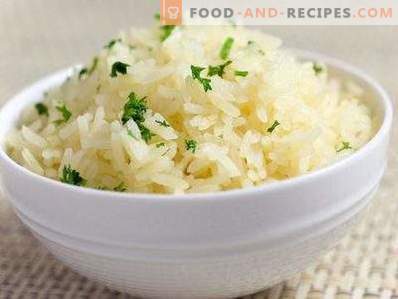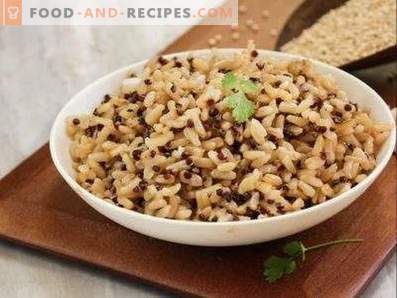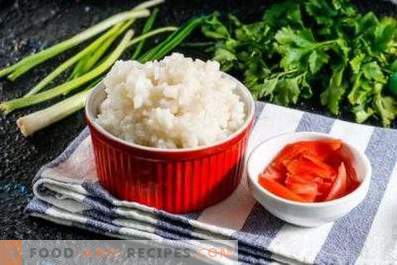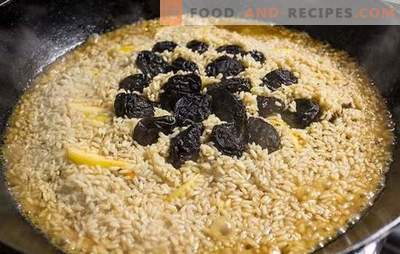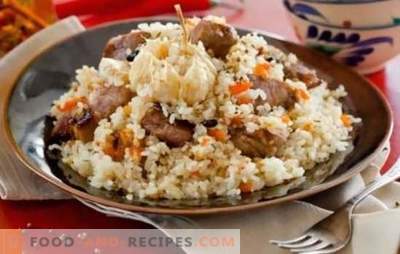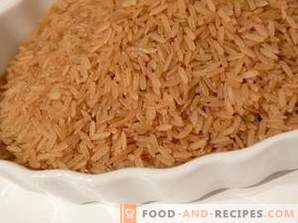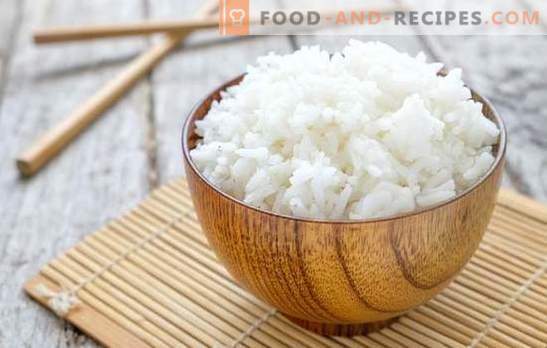
Rice tasteless and sticky? You just do not know how to cook it! You can make amazing side dishes, salads, snacks and even desserts from this cereal. You just need to learn how to cook properly and not make mistakes. Consider the most frequent of them?
Water: the basis of all
Rice is cooked in the usual way or drained in a large amount of water. An example of a classic way is plov, rice for sushi. Drain cooking is carried out in a large amount of water, the surplus of which is removed after cooking. Usually rice simply merges into a sieve or into a colander, whence such a name has come.
Amount of water
So that the liquid is completely absorbed, and the rice is not liquefied, it does not stick together, it is important to accurately measure the water or broth. For crumbly dishes usually use a ratio of 1: 2. That is, for one part of the cereal take two parts of water. This is where a mistake is often made.
What you need to know:
- If the rice was washed and soaked, then it needs less water. Approximately 1: 1.5, and sometimes even 1: 1, it all depends on the degree of swelling.
- If unrefined rice varieties are used, more water is required, sometimes 3 or even 4 parts are needed.
- If the water is measured strictly according to the norm, then rice is boiled under the lid, after boiling it cannot be gurgled, the steam must remain inside the pan. Sometimes an additional cover is wrapped with a wet towel. If steam, that is to say, water comes out, then the rice will remain hard.
It is much easier to cook rice in a draining way, water is taken with a margin. As soon as the cereal comes to readiness, it is drained into a colander, you can even wash it. It is important not to digest here, otherwise the rice will stick together and become limp, it will lose its attractive appearance and shape.
Water temperature
Fill the rice with hot water or fall asleep in boiling water. In no case do not send rice in cold water. Otherwise, the grains will stick together before it all boils. Also, when falling asleep rice should immediately stir it. Otherwise, all this will settle on the bottom and stick. Cold water is poured only rice for sushi.
Soaking errors
Rice should be washed, this is required by almost all types, except steamed cereal. It is believed that white rice, intended for side dishes, salads and other crumbly dishes, should be washed in seven waters. Water washes away dirt and starch from the surface, but much remains inside. Therefore, rice is often still soaked. There is a mistake. When soaking rice cracks, softens, and in the process of cooking the grains fall apart, break up. To prevent this from happening, rice should be soaked in salt water, a whole tablespoon of salt is added to a liter. Before cooking, the cereal is rewashed to remove released starch.
Using the wrong pot
It is very important in what rice is cooked. A big mistake is the use of enamel pans to which everything sticks. Even with a drain method with a large amount of water, the grains will settle and stick.
What is the best way to cook rice:
- cauldron;
- stewpot;
- multicooker;
- pan with thick walls, bottom.
By the way, cheap white rice often turns out to be tasteless. It has a lot of starch, seeds of different sizes, a lot of small crumbs and dust. This product is better not to purchase. If you have already bought rice, you can rinse, fry with oil in a pan, and then pour it into the pan and boil. Sometimes rice is simply dried in a dry frying pan, which also improves its taste.
Frequent stirring
Another reason for the tasteless and boiled rice is its stirring. If we recall the technology of cooking pilau, then it is clearly indicated there. The dish is not stirred during cooking and does not even lift the lid, the rice must absorb all the water and the steam that is released. However, it does not stick and does not stick together.
The golden rule when cooking rice - touch it less!
What happens when stirring? With a spatula or spoon, we damage the swellable grain, the croup gives off starch, which cannot be completely washed, the rice sticks together. If it is of poor quality and soft varieties, then the grains can fall apart during cooking. Instead of a crumbly side dish, you get viscous and slimy porridge.
Spices are not forgotten?
By itself, rice is a tasteless product, it is unleavened, so it goes well with all products: mushrooms, fish, meat, poultry, vegetables, and even sweets. These ingredients will improve the cereal, but in any case, when cooking you need to add spices. Even rice desserts require salt. And it should not be enough. There is even a belief: if rice is prevented 40 times in one direction and the same in another, the porridge will become sweet.
We conclude: a big mistake when cooking rice is to cook it without spices.
What other spices can I add:
- laurel;
- turmeric;
- peppercorns;
- paprika.
Some affect not only the taste, but also the color. Turmeric gives a very beautiful shade. That it is the main component of mixtures for pilaf. You can add garlic and other vegetables, pour soy sauce.
Rice Figure discord
Naturally, one of the most important moments is the variety or type of rice. Even on the shelf of a not very large store you can see a dozen different packs. Naturally, not every rice is suitable for a side dish or pilaf, some varieties will not make milk porridge. Method, cooking time, the amount of liquid depends on the dish and the cereals.
Main types of rice:
- Slash. Crushed cereal, very quickly cooked, releases starch. Ideal for dairy and dairy-free, viscous cereals, requires mandatory washing, can be soaked.
- Steamed rice. This rice can be not soaked or even washed, it is usually just rinsed. The grass has been processed, it does not stick together during cooking, the grain retains its shape. Can be used for pilaf, side dish, but not suitable for porridge. Cooked drain and not drain ways.
- Ordinary round rice (for example, Arborio). Suitable for risotto, paella, various cereals. It is usually boiled in a sufficient amount of water.
- Long rice (Basmati, Indica, Jasmine). These types are used for pilaf, side dishes, salads. Long rice cooked in a limited amount of water or drain method. Some species stick together, so you need to pre-rinse or soak.
- Rice for sushi (Yaponika). It is used for making sushi and rolls, but it is possible to cook porridge from such rice.
Black, brown or red wild rice can also be found on sale. These types are very popular with vegetarians and healthy food supporters. The taste of such cereals is different, they are tougher and contain more fiber, help to diversify the diet.
Such rice cooks longer, usually drain methods and a large amount of water are used.
